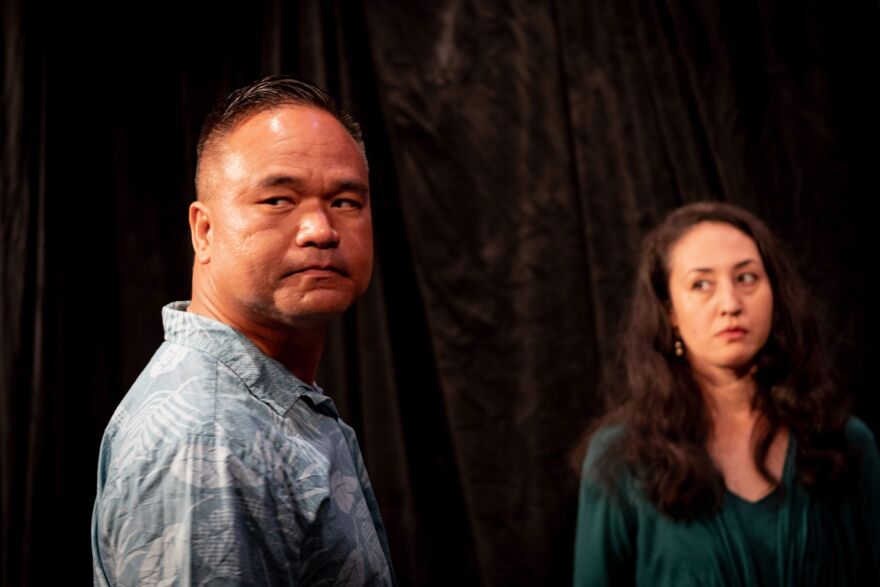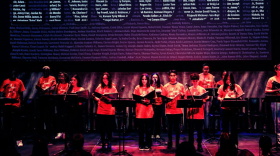A new play opening in Honolulu links history, family, culture, and modern life in Hawai‘i. It’s the final episode in a trilogy that started 25 years ago, and has made some waves along the way. The author agreed to an interview in Kakaako park, well aware that many of the issues dealt with in the play come to a head in the park daily.

Ua Pau premieres at Kumu Kahua Theatre August 22nd, and runs through September 22nd, 2019.
The first part of Alani Apio’s Kamau trilogy, debuted in 1994. It is the story of how Alika chooses to make a living as a tour guide after his family’s fishing grounds are bought by a hotel. In the second play, Alika’s cousin, Michael, returns to the family after a Malcolm X-style education on Hawaiian culture in prison.
I went to Kaka‘ako park yesterday to talk with Apio, because he knows the park well.

“I went homeless for as long as I could,” Apio says, "To see what it was like, and it was the most terrifying, humiliating, degrading, humbling, and enlightening experience that I’ve ever had.”
Apio says he learned what the human spirit is capable of from his friends on the street.
“It’s life unobscured. There’s no veil. There’s no courteous curtain. It’s just in-your-face life, and that helps to be honest in my own writing, and I always strive to do that.”
“My students were blown away by the characters,” says Gail Harada, who holds the literature seat on the Mayor's Culture and Arts Commission. Harada taught Kamau, the first play, for over 10 years in her literature class at KCC.
“They felt they could relate, they recognized those characters. It was just a well written play.”
Harada says metaphor, history, pidgin and Hawaiian language are artfully entwined; there’s a lot for students to unpack and chew on.
“It also brings in all the tensions caused by the struggles to survive economically, to preserve one’s culture. I think it’s important for people to see that kind of struggle.”
Speaking of struggle, Harry Wong is directing part three, Ua Pau: It is Finished, Over, Destroyed. He directed the other two plays, Kamau and Kamau ‘Ae, as well. Wong says the plays somehow get written in the theatre process.
“Because Alani, until he and I and the actors get together, he doesn’t go to what he knows to be true, because he thinks it’s going to be too much.”
Wong points to the fact that the printed version of the first play, Kamau, ends differently from the staged version, which came later.
“It doesn’t end the way the production did because we went into rehearsal with Alika not going back to work. Remember, Alika has to make the choice between supporting his family by fighting for their land, or going back to work to be able to provide for his family.”
Wong continues, “In the original ending, he didn’t go back to work to provide for them until we were getting ready to open. And I said, Alani come, on, tell me what you think he really does." Alani said, "Although I would like him to stand up for his land, I think he goes back to work.” We said, Okay, then let’s do that. And he wrote it and it was heartbreaking.”
Wong says that through the acting, each character’s truth becomes unavoidable. In this part three, as in a mythic hero’s journey, the millennial daughter/niece, Stevie, returns from college and must find a way forward.
“Through what happens to Stevie in this last play you see that at last, the spirit is free to create again, to start anew, to no longer carry the burden, to no longer rage.”
Harada says situations in the plays are not black and white, no easy answers are presented, but in the plays, family and culture remain a source of strength.
“The play (Kamau) starts with voices, and the first time you see Alika he’s giving his canned speech about ‘Iolani Palace. At the end of the play, he gives the same speech, and I ask students, Do you think he gives the speech the same way at the beginning and at the end? Opinions are divided, but one thing some students come to is, he might give the speech in the same way, but we don’t see it the same way. And the teacher in me gets all happy.”
All three parts of the Kamau trilogy are expected to be staged as part of the Pacific Islands Festival of the Arts, summer 2020.





